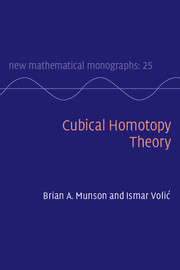8 - Homotopy limits and colimits of diagrams of spaces
from PART II - GENERALIZATIONS, RELATED TOPICS, AND APPLICATIONS
Published online by Cambridge University Press: 05 October 2015
Summary
In this chapter, we generalize homotopy limits and colimits from cubical to arbitrary diagrams of spaces. It should be clear by now that the motivation for this is that limits and colimits are not homotopy invariant (see Examples 2.2 and 2.3) and that it is the job of homotopy limits and colimits to mend this defect. Just as homotopy limits and colimits of punctured cubes are “fattened up” versions of limits and colimits of such diagrams, so too are homotopy limits and colimits over arbitrary indexing categories. The bookkeeping for such fattenings is influenced by the “shape” of the diagram indexing the (co)limit, and involves a certain amount of machinery from the theory of simplicial sets. As we develop this machinery, we shall see how the construction of homotopy limits and colimits of punctured squares and cubes that we have already encountered in Chapters 3 and 5 is indeed a special case of this more general procedure, although this chapter can be read independently of those earlier ones.
The first detailed study of homotopy limits and colimits (in the category of simplicial sets) was undertaken by Bousfield and Kan [BK72a], who in turn followed Segal's definition of a homotopy colimit [Seg68]. Several other special cases were already considered by Puppe [Pup58], Milnor [Mil63], and others. Vogt [Vog73, Vog77] had also independently studied homotopy (co)limits in detail, although much of it in the setting of homotopy commutative diagrams. Special cases of Vogt's work were also considered by Mather [Mat76] (see Theorem 5.10.7 and Theorem 5.10.8).
Bousfield and Kan's preferred model for the homotopy limit of a diagram (of spaces or simplicial sets) is the totalization of the cosimplicial replacement of the diagram. One of the advantages of this point of view is that it leads to spectral sequences computing the homotopy and homology groups of the homotopy limit. We will devote considerable time to discussing this useful feature of the cosimplicial approach in Chapter 9.
One could also discuss homotopy (co)limits as objects that satisfy a homotopical version of the universal properties for (co)limits (see [BK72a], or [Hir03] for a more modern treatment), but the currently prevalent point of view is driven by the modern category-theoretic language of model categories.
- Type
- Chapter
- Information
- Cubical Homotopy Theory , pp. 379 - 442Publisher: Cambridge University PressPrint publication year: 2015



